Have you ever noticed how oil paint gets everywhere? Whenever I paint, I seem to get more on me than on the walls I’m painting. My clothes always end up splattered with tiny droplets. Will they come off? How do you remove oil paint from clothes?
Oil paint should be removed from clothes while it is still wet. Blot away excess paint to prevent it from spreading through the garment. Rinse the item under a cold running tap. Then add some dish soap to the stained area. Wash the garment using laundry detergent. For dried oil paint stains, use paint thinners, acetone, or commercial stain removers.
In this article, we’ll take a look at some of the best ways to get oil paint out of clothes.

Quick Navigation
- Why Does Oil Paint Stain Clothes?
- Does Oil Paint Come Out of Clothes?
- How to Remove Oil Paint From Clothes
- Does Baking Soda Remove Paint From Clothes?
- Does Turpentine Remove Oil Paint?
- Can You Get Dried Oil Paint Out of Clothes?
- How to Get Oil Paint Out of Jeans
- Can You Wash Fabric With Oil Paint on It?
- How to Avoid Getting Oil Paint On Your Clothes
- Conclusion
Why Does Oil Paint Stain Clothes?
Oil paint is designed to add permanent color to surfaces. Normally you would use oil-based paint on interior walls, ceilings, and kitchen cabinets. You can use oil paints on your home’s exterior walls or wooden patio furniture.
It provides a durable coating to protect indoor surfaces from the rigors of day-to-day use. Some oil paints even have a glossy, wipe-clean finish that comes in useful if you have kids that love to doodle. For outdoor furniture, oil paint protects against extreme or inclement weather.
Because of this, it must be long-lasting, resilient to most cleaners, and waterproof. These factors make it incredibly good at covering things. Even things you don’t want to!
This is bad news for your clothes. Although oil-based paint wasn’t designed for fabric, it’s not fussy and will be just as happy to add a spot or two of color to your t-shirt. Usually in a place where you don’t notice the splash until it’s dried.
As oil paint is a liquid, it can sink deep into the fabric of your clothing. Adhering to the fibers and becoming a part of the material. Its grip gets tighter the longer it goes unnoticed, making it difficult to remove.
Does Oil Paint Come Out of Clothes?
Yes, you can get oil paint out of clothes. However, the success at removing the color stain depends on two things. The product you use and how quickly you act.
Speed is definitely of the essence when it comes to getting oil paint out of clothes. You will have more luck removing all traces of paint if you react while it is still wet. This is because the sooner you get the liquid away from the fabric, the less chance the paint has to grab tightly to the fibers.
I’m not saying removing the oil paint will be easy, though! Remember, oil paint is designed to withstand cleaning and water. You’re still going to be facing a battle even with wet paint. It’s a fight you can win, though, as long as time is on your side.
Once the paint has dried, you are in for a tougher challenge. Dried oil paint is going to require the use of chemical removers or paint thinners. While these have a fair chance of success, they can also damage some clothing, particularly if the fibers are petroleum or oil-based.
How to Remove Oil Paint From Clothes
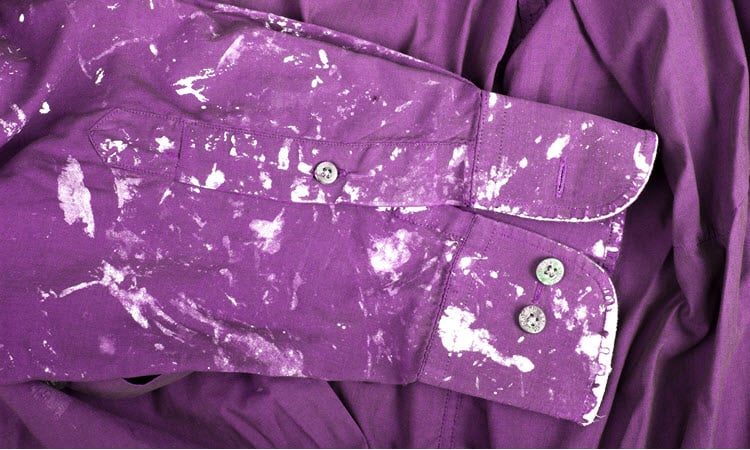
When it comes to removing oil paint from clothes, or any fabric for that matter, you need to act fast! To stand the best chance of getting rid of the paint, that splash or blob dripping down your shirt has got to be still wet. Oil paint stains are easier to deal with when they are still in a liquid form.
The first thing you need to do is remove any excess paint from the fabric of your clothing. Blot it with an old towel to remove the paint before the drip can run or spread to other areas. You want to stop the oil paint soaking into the fibers as soon as possible. Don’t rub the fabric, though. This will push the oil paint further into the garment.
Once you have as much paint off as you can, get that shirt under cold running water. Keep the fabric as wet as possible while figuring out your next move.
Grab the paint tin or can and read the instructions. You want to make sure the paint is oil-based before you start to treat the stain. There are other paints available. Water-based paints, including acrylic, are easier to remove and don’t necessarily need the same kind of products as oil paints.
You’ll find the tin for oil paints will recommend a thinning product or a solvent. Sometimes oil paint can be too thick, so paint thinners are used to help it spread a little easier. This is crucial information as you can use the same thinner listed on the can to remove the oil paint. Better still, the tin should give you instructions on dealing with stains or accidental spills.
There are other products to remove oil paint stains from clothing. I’ve put together a step-by-step list of some of the more tried and tested solutions. You can use this list to work out which option will suit your situation best. Please note that this section focuses on wet paint stains. I’ll cover dried paint stains later in the article.
1. Paint Thinners or Turpentine
 Check your paint can for the name of the thinners recommended for your particular paint. You may find it mentions a product called turpentine. Known as turps for short, this is a well-known paint thinner and remover.
Check your paint can for the name of the thinners recommended for your particular paint. You may find it mentions a product called turpentine. Known as turps for short, this is a well-known paint thinner and remover.
However, use it with caution. Turps is particularly smelly and lets off noxious odors that can make you feel lightheaded. They can also cause headaches. Make sure your room is well ventilated before using paint thinners like turps on your clothes.
You will need:
- Paint thinner recommended on your paint can
- Turpentine
- Clean white cloths
- Well ventilated area
- Rubber gloves
- Paper towels or an old bath towel
- Your garment’s care label
- Cotton balls
- Large bucket
- Dish soap and water
Step 1
Check your garment’s care label to find out the fiber content. Paint thinners like turps can damage synthetic fabrics. If you have a synthetic garment, test the thinners in an inconspicuous area before committing to a full treatment.
Step 2
Blot away any excess or running paint drips. Make sure to blot, not rub. Rubbing will spread the oil paint further into the fabric.
Step 3
When the excess paint has been removed, hold the garment under running water. You must keep the fabric wet.
Step 4
Lay some paper towels on a flat surface. It needs to be a substantial layer to soak up excess paint thinner. You can also use an old bath towel for this. Put your garment on the towels, paint stains facing downwards towards the towel layer. Make sure the area where you do this is well ventilated. Outside would be ideal.
Step 5
Check your paint can and use the recommended paint thinners or solvent. Follow the directions on the tin for removing paint spills. Alternatively, you can use turps.
Step 6
Put on your rubber gloves to protect your hands. Apply turps or paint thinner to the stain with cotton balls. Work the turps into the paint in circular motions, gently pressing down to force the paint out onto the layer of towels.
Step 7
Keep adding turps or paint thinner to the stain until no more paint can be transferred to the towel layer. Saturate the stained area with dish soap and leave the garment to soak in a bucket of water overnight. Then, wash your garment as you would normally.
At the end of the wash cycle, check for signs of paint. Repeat step 6 if some remain. If you are happy they have all gone, dry your garment.
2. Dish Soap
 Dish soap does more than just clean your dishes. It cuts through grease, grime, and paint spills. To do this, it dissolves the adhesive that glues gloop to dishes, or in this case, fibers. Any brand of dish soap will do, although Dawn is known to be particularly effective at breaking down oil. So much so that it’s used to remove oil spills from birds.
Dish soap does more than just clean your dishes. It cuts through grease, grime, and paint spills. To do this, it dissolves the adhesive that glues gloop to dishes, or in this case, fibers. Any brand of dish soap will do, although Dawn is known to be particularly effective at breaking down oil. So much so that it’s used to remove oil spills from birds.
You will need:
- Dish soap
- Bucket of Water
- Clean cloth
- Toothbrush
- Washing machine
- Your usual laundry detergent
Step 1
Blot the oil paint spill with a clean cloth to remove any excess. You want to stop the paint from soaking into the fabric of your clothing or spreading to other areas. Just dab, don’t rub, as rubbing could push the paint further into the material.
Step 2
Add a couple of drops of dish soap to the paint stain. Leave it to sit for a minimum of 15 minutes. Then, use a toothbrush to scrub the stain. You could also use a nailbrush for this.
Step 3
Rinse away the debris under running water. Check for signs of paint residue. If you can still see some staining, repeat step 2. Otherwise, move on to step 4.
Step 4
When you are happy that the paint has been removed as much as possible, wash your garment. Use your usual detergent and machine settings. Check the garment when the wash cycle has ended. If any stains remain, repeat the steps above. Only dry your clothing when you are satisfied with the results.
3. Laundry Detergent and Borax
 Laundry detergent has built-in stain-removing power. Like dish soap, it’s specially formulated to eat away at icky spots, including stains caused by oil-based products. Add a ¼ cup of borax to the mix and you can boost the stain-busting properties of your detergent.
Laundry detergent has built-in stain-removing power. Like dish soap, it’s specially formulated to eat away at icky spots, including stains caused by oil-based products. Add a ¼ cup of borax to the mix and you can boost the stain-busting properties of your detergent.
You will need:
- Your usual laundry detergent
- Borax
- Paper towels
- Washing machine
- Your garment’s care label
Step 1
Blot the oil paint stain with paper towels to remove any excess. Preferably before the oil paint has time to seep into the fibers of the garment. Apply neat laundry detergent to the paint stain and squish it in by scrunching it up in your hand.
Step 2
Leave the detergent to soak into the stain for about ten minutes. Then, put your garment into the washing machine. Wash it by itself. You don’t want the paint transferring to anything else. Check your garment’s care label and set the machine to the warmest setting the clothing can stand. Select a wash cycle that includes a pre-wash setting. If you don’t have one, set the machine for heavily soiled items.
Step 3
Add your detergent and ¼ cup of borax to the machine and switch it on. When the wash cycle has finished, check your garment for signs of oil paint. If some remain, repeat the washing process. When you are happy they have all gone, dry your clothing.
4. WD40
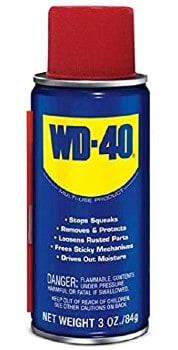 If you find the dish soap or laundry detergent isn’t quite up to cutting through the oil paint, you could try pre-treating the stain with WD40. This is something most of us have in our garage. It’s a degreaser and water dispersant that can also strip paint.
If you find the dish soap or laundry detergent isn’t quite up to cutting through the oil paint, you could try pre-treating the stain with WD40. This is something most of us have in our garage. It’s a degreaser and water dispersant that can also strip paint.
You will need:
- WD40
- Paper towels
- Cardboard
- Your usual washing detergent
- Washing machine
Step 1
Remove as much of the excess paint as you can. Blot it with the paper towels to prevent it from soaking into the fabric.
Step 2
Test the WD40 on an inconspicuous part of your clothing. You want to make sure it won’t cause more damage than the paint.
Step 3
Put the cardboard inside your garment. Make sure it’s directly underneath the stained area. Spray the stain with WD40 and leave it to sit for ten minutes.
Step 4
Wash your garment on the warmest machine setting it can stand. You can use your usual laundry detergent but set the machine on a cycle suitable for heavy staining. Check the laundry detergent container for the correct amount of detergent for heavily soiled clothing.
Step 5
Once the wash cycle has been completed, check the garment for signs of paint. If they are all gone, dry your clothing. For stubborn paint stains, repeat the washing process until you are satisfied with the results.
Does Baking Soda Remove Paint From Clothes?
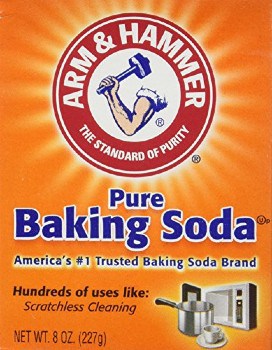
Baking soda is a useful stain remover but isn’t strong enough to remove oil paint from clothes. Not on its own anyway. To use baking soda on an oil paint stain, you’ll need to add it to some other ingredients.
You will need:
- 1 tablespoon baking soda
- 1 cup of water
- 1 tablespoon laundry detergent
- 2 drops of dish soap
- 2 drops of rubbing alcohol
- Small bowl
- Toothbrush or sponge
Step 1
Combine the water, baking soda, detergent, dish soap, and rubbing alcohol in the small bowl. Stir them around to make sure they are well mixed.
Step 2
Dip your toothbrush or sponge into the mixture and apply it to the paint stain. Gently scrub at the stain to lift off the paint particles. For lightly soiled items, you can use a sponge. If the paint has dried a little, try a toothbrush.
Step 3
Leave the mixture on the garment for about ten minutes. Then rinse it off under running water. Next, wash your clothing as you would normally. Check for signs of paint stains when the wash cycle has been completed. If you are unhappy with the results, repeat these steps to see if any more paint can be removed. Don’t dry the garment until you are completely satisfied that you’ve got rid of as much paint as you can.
Does Turpentine Remove Oil Paint?
Turpentine is an organic solvent derived from tree resin. It can be used as a paint thinner and it can also be used to remove oil-based paint. Not just from clothes either. Artists have used turpentine to clean oil paint from their paintbrushes for years.
However, it’s not necessarily the best product for the job. The one thing you have to watch with turpentine, or turps, is it can be unpleasant to use. It has a strong odor and can cause headaches. Not only that, but it can also cause skin irritation. Although it is a natural product made from tree sap, it can damage some fabrics, particularly synthetic ones.
This is because turps is a degreaser capable of cutting through oil-based solutions. As most synthetic fibers are oil-based, this can be a problem. Always do a spot-test in an inconspicuous area of your garment before attempting to remove an oil paint stain with turpentine.
Can You Get Dried Oil Paint Out of Clothes?
Yes, you can get dried oil paint out of clothes, up to a point. But it’s not as easy to remove as wet paint. Nor is it guaranteed to be as effective. You might find you only manage to get rid of some paint stains. Leaving you with visible paint marks and more than a little bit of residue.
Paint, especially oil paint, is much easier to deal with while it is still wet. As a liquid, it’s a simple case of getting other liquids to wash the paint away. When it’s dried, it becomes solid and has a better grip on the fibers of your clothing. Thus creating a stubborn mark buried deep into the fabric of your garment.
Although it’s not impossible to get rid of dried oil paint from your clothes, it will be a challenge. You may have to admit defeat and live with the oil paint stain rather than remove it completely.
There are some methods you can try before you give up on your oil-painted t-shirt. As most of the following solutions involve some form of chemical or stringent paint stripper, you will have to check your garment first.
Any synthetic content is likely to be damaged by the solvents you’ll need to use to remove the paint. With that in mind, let’s take a look at some of the options for removing dried oil paint from clothes.
1. Commercial Stain Remover
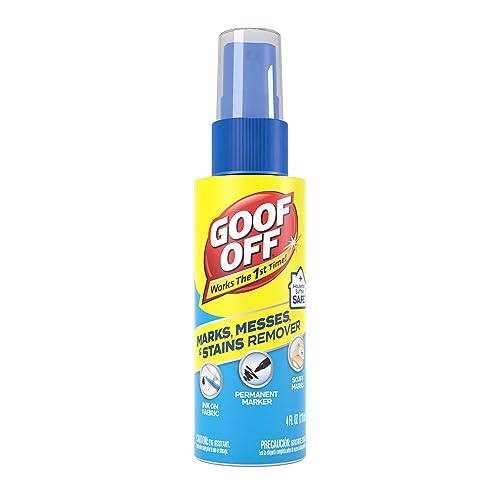 There’s no doubt about it; paint stains are a part of life. Because of this, paint manufacturers will list removal products on the tin. Usually, the product you can use to remove the stain is the same as the one you use to thin the paint.
There’s no doubt about it; paint stains are a part of life. Because of this, paint manufacturers will list removal products on the tin. Usually, the product you can use to remove the stain is the same as the one you use to thin the paint.
Before you consider using a stain remover such as Goof Off, check your paint can for details on the recommended solvent for that particular paint. One of the issues with commercial stain removers is they may not be strong enough for oil-based paint. Most of them are aimed at latex or other water-based paints.
It’s always best to go with the manufacturer’s guidelines for oil paint removal. Particularly when the paint is dry. Most of the time, oil paints need paint thinners or turpentine to remove them effectively. Check out the step-by-step guide on removing oil paint from clothes above.
2. WD40
A useful product to have in your garage, WD40 can remove more than grease and oil, and can also strip dried paint from surfaces.
However, there is a word of caution. WD40 is best used on heavier fabrics like denim or canvas. Lighter fabrics may not fair so well. Always perform a spot test on your garment before treating it with WD40.
You will need:
- WD40
- Cardboard
- Scraper/toothbrush
- Dish soap
- Your usual washing detergent
- Washing machine
Step 1
Put the cardboard inside the garment. Have the side with the paint stain facing you. Spray with WD40 and leave it for ten minutes.
Step 2
Gently lift the dried paint with your toothbrush. The surface of the paint stain should lift off in flakes. If it doesn’t, add a little more WD40 and leave it to soak for a bit longer. After ten minutes, try again. You won’t get all the stain off. This step is to get rid of as much of surface paint as you can.
Step 3
Add a couple of drops of dish soap to the remaining paint stain. Squish it into the stain with your fingers. Leave it to soak for about twenty minutes. Then put your garment in the washing machine. Use the warmest setting the garment can stand and a cycle suitable for heavily soiled clothing.
Step 4
When the cycle is complete, check the garment for paint stain residue. If some remain, repeat the process. However, be prepared to settle for nearly gone. Because the paint was dry, you may not be able to get all of the residue out of the clothing.
3. Acetone
Acetone is a solvent used to dissolve rubber, plastics, and oil. It’s one of the ingredients used in paint strippers. You can even find it in nail polish remover.
However, acetone is fatal to any garment containing acetate. Rather than remove oil paint from an acetate shirt, you’ll melt it. The same goes for modacrylics. If you are in any doubt about the fiber content of your garment, don’t use acetone.
The method for using acetone is the same as for paint thinners and turpentine. Check out the section above entitled how to remove oil paint from clothes for step-by-step instructions.
4. Camouflage
Sometimes it’s best to admit defeat, especially with oil paint stains. It’s better to live with the blot on your shirt than risk causing more damage to the fabric.
Paint-splattered garments are on-trend. So much so that people drip paint all over their clothes on purpose. It creates a distressed look that is highly fashionable right now. Why not rock the random paint drops? Instead of ruining a shirt, you’ve just improved your street cred!
You could also try hiding the paint stain. Try tie-dyeing the garment, so the paint stain becomes part of a unique and individual design. Again, your painting disaster could become your key to being the latest fashionista.
Failing that, you could try sew-on or iron-on patches. An embroidered design strategically placed over the top of the oil paint will hide your painting boo-boo from sight.
How to Get Oil Paint Out of Jeans
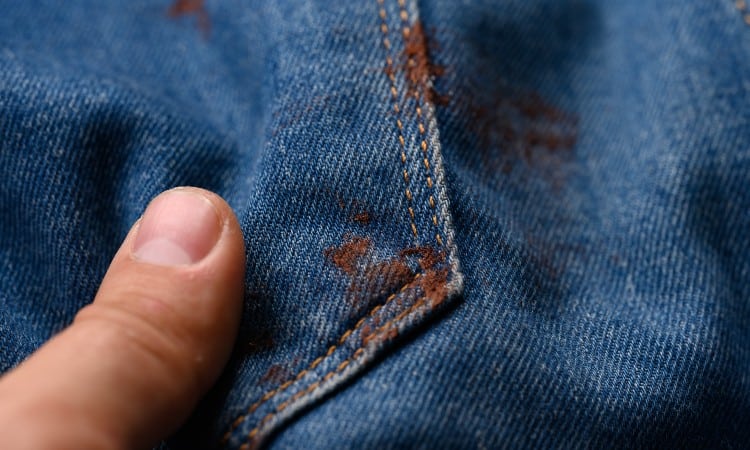
Getting oil paint out of jeans can be easy or hard, depending on the type of stain you are dealing with. For fresh stains that are still wet, use any of the methods listed in the section above called how to remove oil paint from clothes.
Pay attention to the fiber content of your jeans, though. Any synthetic material like stretch denim may be damaged by paint thinners or turpentine. If you are unsure about the fiber content, stick with one of the options using dish soap or laundry detergent.
For dried-on oil paint, you’ll need to use a chemical stain remover. You can purchase these from big box stores or an online outlet. Again, be careful the product is safe to use on synthetic fabrics if there is any chance your jeans contain polyester or lycra.
As with all garments, you stand more chance of getting oil paint out of jeans while the paint is wet. So act quickly. You should also keep your jeans wet until the oil paint has been removed.
Can You Wash Fabric With Oil Paint on It?
You can wash fabric with oil paint on it. Washing is one of the methods you can use to remove oil paint from clothes.
However, it needs to be wet paint and you need to pre-treat it with one of the remedies mentioned above. Simply washing your oil paint-splattered t-shirt isn’t going to remove the stains.
It is not advisable to wash garments with wet oil paint stains as this will spread the paint through the material, making the stain worse. Especially if there is any excess paint present. Always treat the wet paint before attempting to wash it out.
Dried-on stains are permanent, so the paint won’t come off or spread to other clothing. Unless you’ve treated it with one of the methods listed above for dried-on oil paint, that stain isn’t going anywhere. It won’t transfer to any other garment, nor will it come off in the wash.
How to Avoid Getting Oil Paint On Your Clothes
Rather than deal with dripping paint or splatters landing on your clothes, it’s better to protect your clothing while you paint. There are several ways you can do this.
The easiest thing you can do is wear old clothes. Put on an old baggy t-shirt and jeans that have seen better days. Or an old pair of pajamas. Wear anything that you don’t mind getting covered in paint.
Whether you’re painting a portrait or your bedroom ceiling, it’s not the time to wear your Sunday best. Embrace your inner rebel and dress down.
If old clothes aren’t an option, you can wear coveralls or overalls. These can be purchased from the same place as the paint. Usually made from light plastic, they come in different sizes and are disposable.
Drop cloths are also a good idea for protecting fabric you can’t move. These can be old bedsheets or specific plastic drop cloths from your hardware store. You won’t have to worry about getting paint off your carpet fibers.
Another thing to consider is changing the type of paint you are using. Oil paint has always been the go-to paint for surfaces that need a durable finish. It’s not particularly ecological, though and, as we’ve seen in this article, makes the clean-up process a nightmare.
Why not try acrylic paint? Acrylics dry quickly, which is great news if you are an artist. No more wet canvasses laying about for days. So there’s less chance of you getting paint on your clothes.
New acrylic paints give the same quality of finish to walls, ceilings, and wooden surfaces. Better still, acrylic paint is washable. You don’t need to use turpentine or paint thinners to remove it, which makes the clean-up process a breeze.
Lastly, whatever paint type you are using, give it space and leave it to dry. Remember you’ve painted your surfaces and tell everyone in your household about the wet paint. If you can, put something in front of your freshly painted surface to remind you to give it a wide berth for a couple of hours.
Conclusion
Oil paint can be a challenge to remove. As long as you treat the paint stain while it is still wet, you have a better chance of success. For difficult or dried-on stains, you’ll need to use paint thinners or turpentine.
Pay attention to the fiber content of your clothes, though. Synthetic materials can react badly to paint stripping products.
For a hassle-free painting, experience wear old clothes and use drop cloths. That way, you won’t need to worry about removing oil paint from clothes.